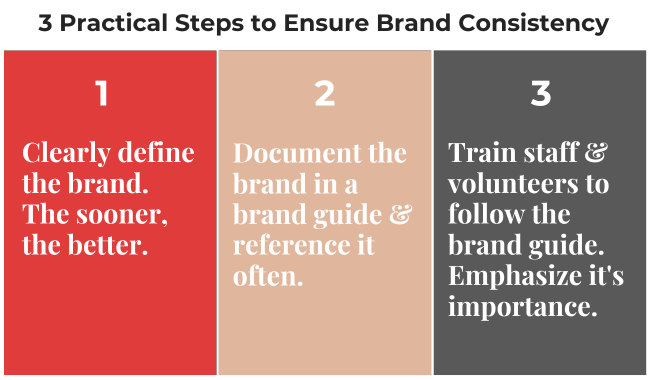In the fast-paced, cut-throat world of politics where public perception can change quite quickly, maintaining a strong, consistent brand is crucial for any political candidate. Brand consistency is important for political candidates as it helps build trust, recognition, and a loyal voter base. It ensures the candidate’s message is clear, their values are understood, and their presence is felt across various platforms and mediums.
Let’s explore why brand consistency is essential for political candidates. We’ll look at its benefits, the risks of inconsistency, and practical steps for maintaining a cohesive brand.
Why Brand Consistency is Important for Political Candidates
Political campaigns are essentially marketing campaigns. Just like in business where a consistent brand image can drive customer loyalty, both candidates and incumbents need a consistent brand to foster voter loyalty. A clear and consistent brand helps voters identify with the candidate and their platform. When voters see the same colors, logos, slogans, and messaging across all campaign materials, it creates a sense of familiarity and reliability. The candidate appears more authentic and professional.
Moreover, brand consistency is important for candidates and elected officials because it helps to reinforce the candidate’s core message. Whether it’s through speeches, social media posts, or campaign advertisements, consistent branding ensures that the candidate’s values and promises are communicated clearly and effectively. This alignment makes it easier for voters to remember the candidate’s stance on key issues. Also, they are more likely to trust that the candidate will follow through on commitments.
The Risks of Inconsistent Branding for elected officials and candidates
Inconsistent branding can severely undermine a political campaign. When voters receive mixed messages or see different images and slogans associated with the same candidate, it creates confusion and doubt. They may question the candidate’s reliability or authenticity. For example, if a candidate’s social media pages convey a different message or tone than their official website or public appearances, voters may find it difficult to understand where the candidate truly stands on issues.
Additionally, inconsistent branding can make a candidate appear disorganized and unprofessional. Voters expect their leaders to be competent and reliable. Inconsistent branding suggests a lack of control and attention to detail, which can be damaging to a candidate’s image. Consistency is important for political candidates because it projects an image of stability and professionalism, qualities that are essential for gaining public trust and support.
No elected official or candidate for office wants a negative story to appear in any form of media. An inconsistent public brand invites harsh criticism for all of the above reasons. It can also be used to bring integrity and honesty into question. Depending on the office being sought, this could happen anyway. However, when a candidate has impeccable brand consistency many voters will be quite understanding and forgiving of bad press.
Building Trust as a candidate Through Brand Consistency
Trust is a cornerstone of any successful political campaign. Brand consistency is important for political candidates because it helps build and maintain this trust. When a candidate consistently presents the same message, values, and visual identity, it reassures voters that the candidate is stable and reliable. This trust can translate into votes, as voters are more likely to support a candidate they believe in and feel connected to.
For instance, using a consistent color scheme and logo across all campaign materials, from flyers to social media posts, helps reinforce the candidate’s identity. When voters see these elements repeatedly, they begin to associate them with the candidate’s values and message. This repetition builds familiarity, and over time, familiarity breeds trust. When voters trust a candidate, they are more likely to advocate for them and encourage others to support them as well.
3 Practical Steps to Ensure Brand Consistency
Ensuring brand consistency requires a strategic approach:
- Clearly define the brand. The sooner, the better.
- Document the brand in a brand guide and reference it often.
- Train the staff and volunteers to follow the brand guide and emphasize why it’s important.

Political candidates should start by defining their brand clearly – and early. This includes establishing their core message, values, and visual identity. The core message should be concise and reflect the candidate’s primary goals and values.
Once these elements are defined, they should be documented in a brand guide that can be referenced throughout the campaign. A brand guide should include guidelines for visual elements such as logos, color schemes, and typography, as well as tone and voice for written and spoken communications. By adhering to these guidelines, all campaign materials can maintain a unified look and feel. This helps ensure that no matter where voters encounter the candidate’s message—be it on a billboard, social media, or in a TV commercial—it feels consistent and recognizable.
Another critical step is training all campaign staff and volunteers on the importance of brand consistency. Everyone involved in the campaign should understand the brand guide and follow it diligently. Regular training sessions and updates can help keep everyone on the same page. This makes it easier to ensure the brand is consistently applied across all touch points.
Leveraging Social Media for political Brand Consistency
In today’s digital age, social media is a powerful tool for political campaigns. However, it also presents challenges for maintaining brand consistency. Given the rapid pace and diverse platforms, it’s easy for messaging to become fragmented. Nonetheless, brand consistency is important for political candidates on social media. It helps them cut through the noise and make a lasting impression.
This is where you brand guide comes in handy.
Candidates should use social media platforms strategically, ensuring that their posts reflect their core message and maintain the visual identity outlined in the brand guide. This means using the same profile pictures, cover photos, and handles across all platforms. Posts should be crafted to reflect the candidate’s tone and values. Any graphics or videos shared should follow the established visual guidelines.
Moreover, candidates should engage with their audience in a consistent manner. Whether responding to comments, participating in discussions, or sharing updates, the communication style should align with the overall brand. Consistent interaction helps reinforce the candidate’s presence and reliability, further building trust with voters. For that matter, if the candidate chooses to adopt a policy of NOT interacting on social media, that’s fine as long as it’s consistent.
Measuring & Improving Brand Consistency
Maintaining brand consistency is an ongoing process. Political candidates should regularly review their campaign materials and strategies to ensure alignment with the brand guide. This can involve conducting audits of social media posts, advertisements, and public statements to check for consistency.
Feedback from voters can also provide valuable insights. Candidates should pay attention to how their brand is perceived by the public and be open to making adjustments if necessary. While it’s important to stay true to the core message and values, being adaptable to voter feedback can help refine the brand and improve its effectiveness.
Conclusion
In the competitive world of politics, where perception is key, brand consistency is important for all political candidates. It helps build trust, ensures clear communication, and creates a recognizable and reliable image. Inconsistent branding, on the other hand, can lead to confusion and doubt, damaging a candidate’s reputation. By defining a clear brand, adhering to a brand guide, and leveraging social media strategically, candidates can maintain a consistent brand that resonates with voters and strengthens their campaign.
When voters know what to expect, they feel comfortable and are more trusting. Ultimately, brand consistency can be the difference between winning and losing an election, making it an essential element for any political candidate to master. Please contact us if you have any questions about consistency in branding, particularly what that can mean for your campaign website.




